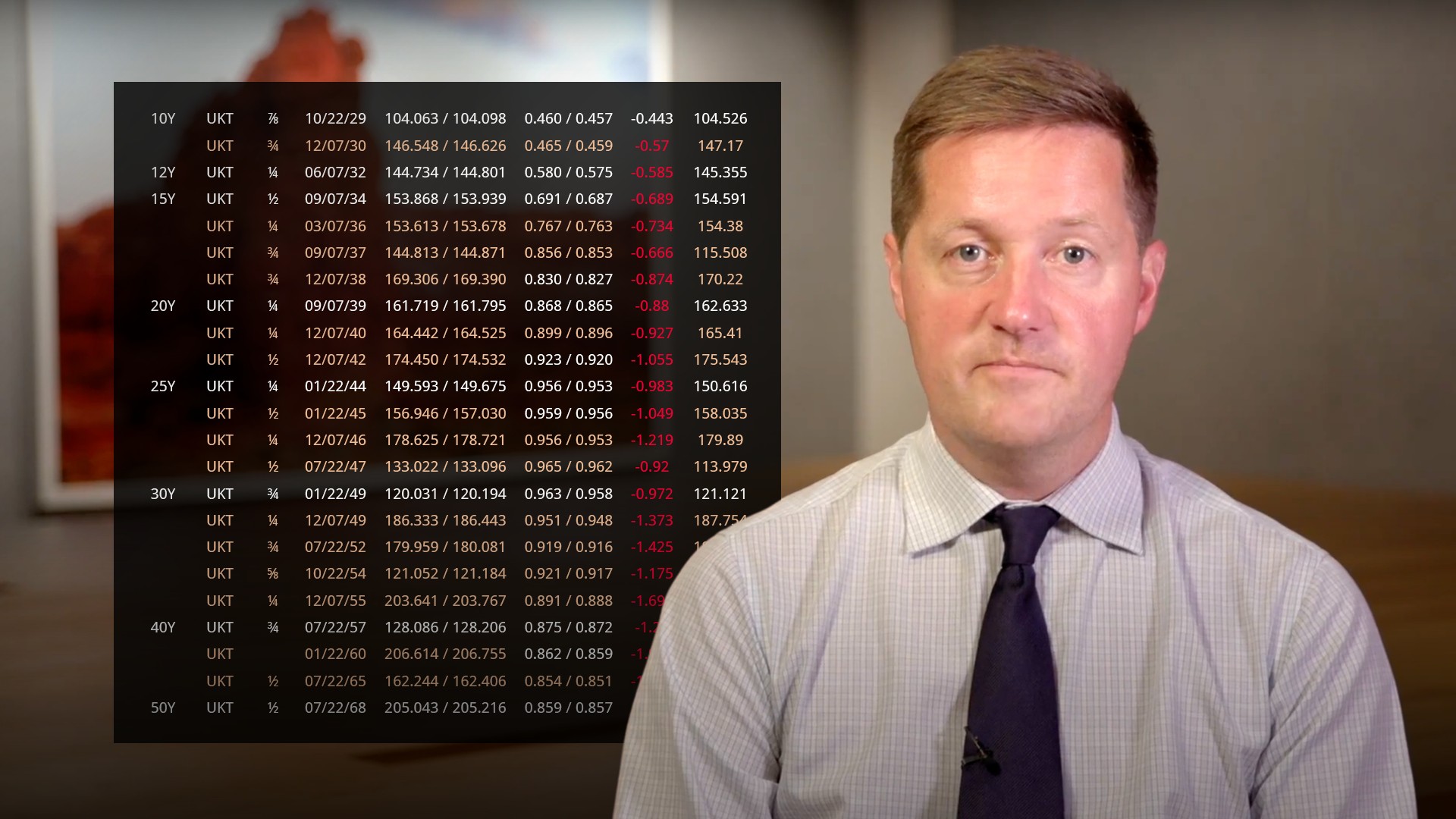
Pricing Sterling Bonds

Nigel Owen
20 years: Debt capital markets
In this third part of the series of how to price a bond, Nigel outlines the process of pricing a Sterling denominated bond for the theoretical issuer, XYZ Corporation, using the building blocks outlined in the introductory video. In this example, XYZ has chosen to issue a 30-year bond.
In this third part of the series of how to price a bond, Nigel outlines the process of pricing a Sterling denominated bond for the theoretical issuer, XYZ Corporation, using the building blocks outlined in the introductory video. In this example, XYZ has chosen to issue a 30-year bond.
Subscribe to watch
Access this and all of the content on our platform by signing up for a 7-day free trial.

Pricing Sterling Bonds
8 mins 22 secs
Key learning objectives:
Understand how a bond yield is reflected in the bond price
Identify the convention used in the sterling bond market for coupon payments
Understand how a bond’s yield to maturity is calculated in the sterling bond market
Describe the Gilt benchmark rules for sterling bond issues
Describe the coupon rounding convention in sterling
Understand the day-count convention for sterling and its uses
Overview:
A bond represents a series of cash-flows. Investors buying bonds acquire rights to receive those cash-flows at a series of dates – the interest payments during the life of the bond (the coupons) and return of the money at maturity (redemption). For new bonds, buyers and sellers need to agree a price and a yield (discount rate) to arrive at a present value, or price, at which they can transact. The yield is a component of the risk-free rate plus a risk premium (a credit spread). The choice of benchmark hinges on the currency of issue and the conventions that apply to bonds issued in that currency.
Subscribe to watch
Access this and all of the content on our platform by signing up for a 7-day free trial.
What convention is used in the sterling bond market for coupon payments?
XYZ Corp has opted to issue a 30-year bond in sterling. The company needs to decide the interest payments – or coupons – to which the bond’s eventual owners will be entitled. Bonds in sterling are conventionally issued with annual coupons. Therefore the holder of a bond with a 4% coupon would receive that every 12 months.How is a bond’s yield to maturity calculated in the sterling bond market?
The bond’s cash flows need to be discounted to calculate the yield of the bond. Calculating the yield on the bond has two components:
- The risk free rate. Every bond market has what is known as a benchmark rate, which is either the government bond curve or an established swap curve. In the UK, the UK Government, or Gilt, curve is used as the benchmark for pricing fixed rate bonds.
- The credit spread, which is the additional compensation investors demand to take on the extra risk of lending to a corporate issuer. This risk premium is quoted in basis points (i.e. 1/100s of a percentage point). The credit spread agreed with XYZ’s investors is 200 basis points or 2%. Adding that spread to the yield of the benchmark yield gives us a yield to maturity of 2.963% (2%+0.963%).
How does XYZ know which bond to use as its benchmark? The Sterling bond market has very defined rules on how to decide which Gilt to use. Unlike most markets, benchmark Gilts are not assigned to a nominal maturity such as five years or 10 years but rather by the calendar.
What are the Gilt benchmark rules for sterling bond issues?
For a Gilt to be considered as a benchmark, it needs to be at least £10bn in size. From there, the following rules apply:- When there is only one benchmark in that calendar year, that benchmark is used
- When there is no benchmark in that calendar year, the nearest benchmark with a shorter maturity is used
- If there is more than one benchmark in that calendar year:
- The benchmark with the same maturity month as the bond you are pricing is used
- If there is no benchmark with the same maturity month, the nearest benchmark with a shorter maturity in the same calendar year is used
- If there is no benchmark with the same or shorter maturity month, the nearest benchmark in the same calendar year is used
What is the coupon rounding convention in sterling?
With a yield to maturity of 2.963% and a redemption value of £100, assigning an issue price could be a really simple exercise: assigning a coupon of 2.963% and an issue price of 100 (or to use the jargon, par). The present value of a bond paying 2.963%, discounted at a rate of 2.963% is par. However, convention dictates that bond coupons are rounded down to the nearest 1/8th of 1%. This means a coupon for XYZ of 2.875%.How is a bond yield reflected in bond price?
To reflect the 2.963% yield on a bond paying a 2.875% coupon, the issue price needs to be discounted. This discount can be calculated for every single cash-flow to derive a series of net present values, which can be added up to equal the appropriate issue price for the bond. For simplicity, a bond calculator can be used. Either way will tell you that to give investors a yield to maturity of 2.963%, XYZ’s bond should have an issue price of 98.267.What is the day-count convention for sterling and what is this used for?
To help future investors value and trade the bond during its life, day-count and business day conventions need to be borne in mind. As soon as XYZ’s bond is issued, it is free to trade, which means investors are free to buy and sell the bonds. The issuer’s obligation to pay coupons and redeem the bonds at maturity is limited to who owns the bonds at the time the obligations become due. Since coupons are usually only paid annually, it is typical in the sterling market for each investor who sells bonds to have the buyer compensate them for interest accrued during the time they held the bond.
Day-count conventions set the framework for investors to calculate interest accrued when a bond has not been held for the full period of a coupon. In the sterling market the convention is for accrued interest to be calculated on an Actual/Actual basis i.e. the calculation uses the actual number of days in the shortened period and the actual number of days in the full interest calculation period.
Subscribe to watch
Access this and all of the content on our platform by signing up for a 7-day free trial.

Nigel Owen
There are no available Videos from "Nigel Owen"



























